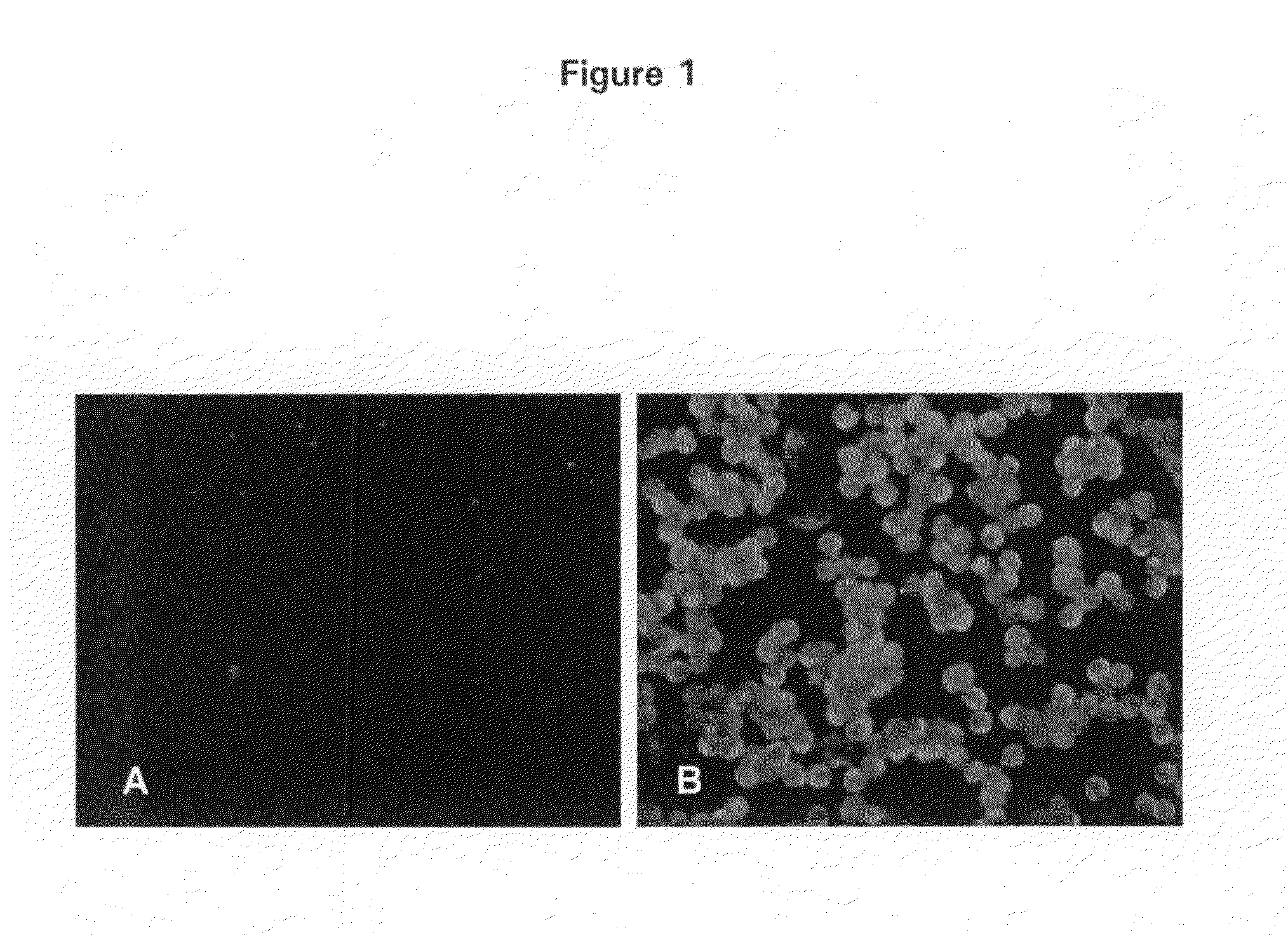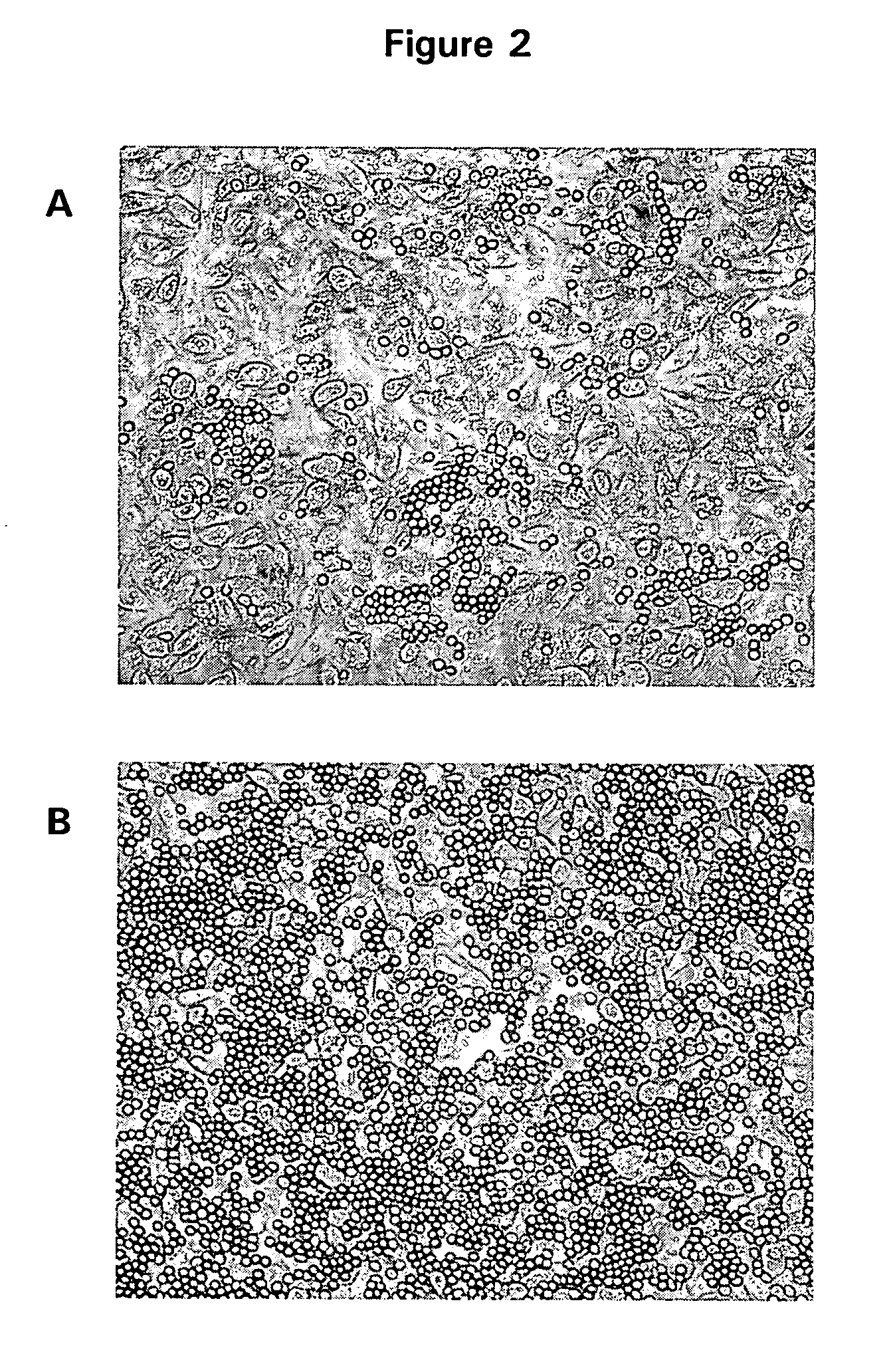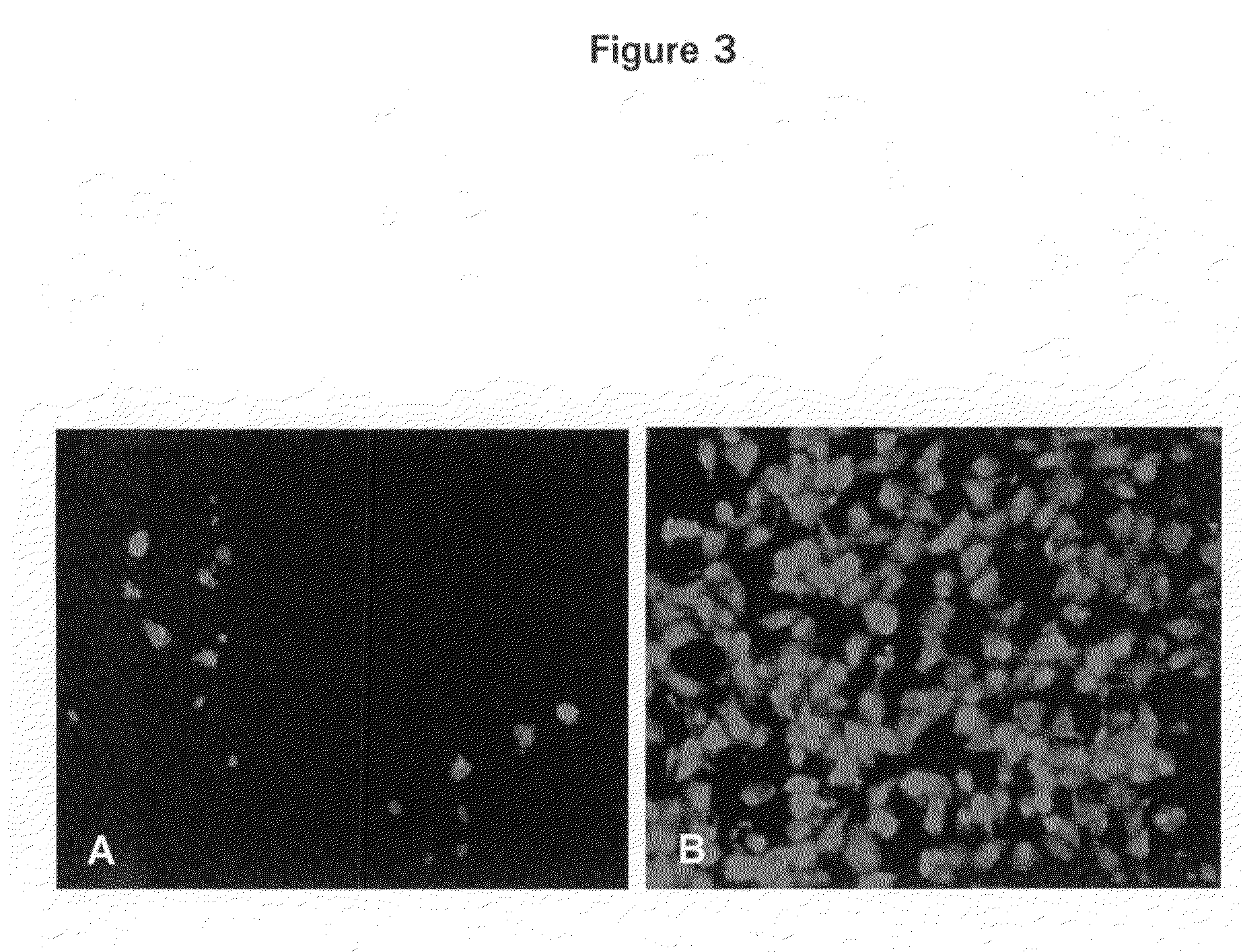[0007]In particular, the invention provides a transgenic
cell line designated Mv1Lu-hF. The invention also provides a cell line established from a transgenic cell line designated Mv1Lu-hF, wherein the
established cell line has a property selected from the group consisting of (a) increased sensitivity to at least one
virus selected from the group consisting of
influenza A virus, influenza B virus and parainfluenza virus 3, as compared to the Mv1Lu cell line, and (b) enhanced productivity of infectious virions upon
inoculation with at least one virus selected from the group one consisting of
influenza A virus, influenza B virus and parainfluenza virus 3, as compared to the Mv1Lu cell line. In some embodiments, the cell line has the sensitivity of the cell line designated Mv1Lu-hF, to at least one virus selected from the group consisting of
influenza A virus, influenza B virus and parainfluenza virus.
[0008]The present invention also provides a transgenic mink lung epithelial cell line expressing human
furin, wherein the cell line has a property selected from the group consisting of (a) increased sensitivity to at least one virus selected from the group consisting of
influenza A virus, influenza B virus and parainfluenza virus 3, as compared to Mv1Lu, and (b) enhanced productivity of infectious virions upon
inoculation with at least one virus selected from the group one consisting of influenza A virus, influenza B virus and parainfluenza virus 3, as compared to Mv1Lu. In preferred embodiments, human
furin is encoded by the sequence SEQ ID NO:1. In some embodiments, the transgenic mink lung epithelial cell line has the sensitivity of the cell line designated Mv1Lu-hF to at least one virus selected from the group consisting of influenza A virus, influenza B virus and parainfluenza virus 3.
[0009]Also provided by the present invention is a composition comprising a transgenic mink lung epithelial cell expressing human
furin, wherein the cell has a property selected from the group consisting of (a) increased sensitivity to at least one virus selected from the group consisting of influenza A virus, influenza B virus and parainfluenza virus 3, as compared to the Mv1Lu cell line, and (b) enhanced productivity of infectious virions upon
inoculation with at least one virus selected from the group one consisting of influenza A virus, influenza B virus and parainfluenza virus 3, as compared to the Mv1Lu cell line. In some embodiments, the composition further comprises a second
cell type different from the transgenic mink lung epithelial cell, and wherein the transgenic mink lung epithelial cell and the second
cell type are in mixed-
cell type culture. In related embodiments, the second cell type is selected from the group consisting of primary monkey
kidney, BS-C-1, CV-1, Vero, Vero 76, Vero C1008, Vero 76, Cos-1, Cos-7, FRhK-4, LLC-MK2 original, LLC-MK2 derivative, MDCK, RD, A549, MRC-5, KB, and CaCo-2 cells.
[0011]Also provided by the present invention is a composition comprising a cell established from a transgenic cell line designated Mv1Lu-hF, wherein the established cell has a property selected from the group consisting of (a) increased sensitivity to at least one virus selected from the group consisting of influenza A virus, influenza B virus and parainfluenza virus 3, as compared to the Mv1Lu cell line, and (b) enhanced productivity of infectious virions upon inoculation with at least one virus selected from the group one consisting of influenza A virus, influenza B virus and parainfluenza virus 3, as compared to the Mv1Lu cell line. In some embodiments, the composition further comprises a second cell type different from the established cell, and wherein the established cell and the second cell type are in mixed-cell type culture.
[0015]Additionally the present invention provides a transgenic Madin Darby
canine kidney (MDCK) cell line expressing human furin. In some embodiments, the cell line has increased sensitivity to influenza A virus, as compared to MDCK cells deposited as ATCC number CCL-34 and / or the cell line has enhanced productivity of infectious virions upon inoculation with influenza A virus, as compared to MDCK cells deposited as ATCC number CCL-34. In some preferred embodiments, the human furin is encoded by the sequence SEQ ID NO:1. Compositions comprising culture medium and a cell of the transgenic
MDCK cell line expressing human furin are also provided by the present invention. Moreover method for detection of a virus selected from the group consisting of influenza A virus, influenza B virus and parainfluenza virus 3, in a sample are provided, comprising: providing: i) a sample suspected of containing the virus; and ii) a composition comprising a cell of the transgenic
MDCK cell line expressing human furin; inoculating the cell with the sample to produce an inoculated cell; and observing the inoculated cell for the presence of the virus. In some embodiments, the composition is a mixed-cell type culture further comprising a second cell type different from the transgenic Madin Darby
canine kidney (MDCK) cell line expressing human furin. Other embodiments further comprise providing a
monoclonal antibody selected from the group consisting of an influenza A virus-reactive
monoclonal antibody, an influenza B virus-reactive
monoclonal antibody, and a parainfluenza virus 3-reactive
monoclonal antibody, and using the
monoclonal antibody for observation of the virus. Kits for detection of a virus selected from the group consisting of influenza A virus, influenza B virus and parainfluenza virus 3, in a sample, are provided, comprising: a composition comprising a cell of the transgenic
MDCK cell line expressing human furin; and a
monoclonal antibody selected from the group consisting of an influenza A virus-reactive monoclonal antibody, an influenza B virus-reactive monoclonal antibody, and a parainfluenza virus 3-reactive monoclonal antibody. In some embodiments, the composition is a mixed-cell type culture further comprising a second cell type different from the transgenic Madin Darby
canine kidney (MDCK) cell line expressing human furin. In some preferred embodiments, method for producing virus selected from the group consisting of influenza A virus, influenza B virus and parainfluenza virus 3 are provided, comprising: providing: i) a sample containing the virus, and ii) a composition comprising a cell of the transgenic MDCK cell line expressing human furin 1; and inoculating the cell with the sample to produce an inoculated cell, wherein the cell produces the virus.
[0016]Furthermore the present invention provides Madin Darby canine
kidney (MDCK) cell lines expressing human furin, obtained by a method comprising: providing: i) MDCK cells, and ii) a vector comprising a sequence encoding human furin and a
selectable marker, introducing the vector into the MDCK cells to produce transfectants; contacting the transfectants with a selection medium to obtain stable transfectants; and selecting stable transfectants expressing human furin to obtain a MDCK cell line expressing human furin. In some preferred embodiments, the cell line has increased sensitivity to influenza A virus, as compared to MDCK cells deposited as ATCC number CCL-34 and / or enhanced productivity of infectious virions upon infection with influenza A virus, as compared to MDCK cells deposited as ATCC number CCL-34. Other embodiments provide a clone of the transgenic MDCK cell line expressing human furin. In some preferred embodiments, the human furin is encoded by the sequence set forth in SEQ ID NO:1. Compositions comprising culture medium and a cell of the transgenic MDCK cell line expressing human furin are also provided by the present invention. In still further embodiments, the present invention provides methods for detection of a virus in a sample, wherein the virus is selected from the group consisting of influenza A virus, influenza B virus, and parainfluenza virus 3, comprising: providing the transgenic MDCK cell line expressing human furin; and inoculating the cell line with a sample suspected of containing a virus selected from the group consisting of influenza A virus, influenza B virus, and parainfluenza virus 3, to produce an inoculated cell; and observing the inoculated cell for the presence of the virus. In some preferred embodiments, observing comprises one or both of hemadsorption and
immunofluorescence staining.
 Login to View More
Login to View More 


